Voigtlander Camera Serial Numbers

CameraQuest has the internet's largest information pages on Cosina Voigtlander products. CameraQuest is also a classic camera resource, especially rangefinder cameras. CameraQuest has the internet's largest information pages on Cosina Voigtlander products. CameraQuest is also a classic camera resource, especially rangefinder cameras. Mar 30, 2010 Hello, I am trying to find out the year my Vitessaa was manufactured and I can't find a list of serial numbers for the Voightlander bodies. Hello, I am trying to find out the year my Vitessaa was manufactured and I can't find a list of serial numbers for the Voightlander bodies.
Coolsand Usb Driver Aplikasi Sistem Informasi Kepegawaian Full Metal Jacket. more. In 1900, Carl August Hans Harting filed a patent for what would be the first version of the now famous, Heliar lens. The Harting design was essentially a modification of the Cooke Triplet, with two additional elements and a symmetrical layout. These changes helped address the Triplet's short comings of longitudinal aberrations while still allowing for a wide (fast) aperture. The lens had a speed of f/4.5 and covered 50 degrees. Its large aperture made it suitable for portraiture and instantaneous work. In performance terms, the Dynar was superior to the Heliar in all aspects but astigmatism.
Its speed was advertised at f/6 with 60 degrees of coverage, despite the design actually allowing for a much faster aperture. This was done as to not directly compete with the very popular and profitable Heliar. As such, Voigtlander continued to sell both the Heliar (1902 f/4.5 design) and the Dynar, side-by-side into the early 1920's. About 1925, Voigtlander decided to tweak the Dynar design and created an f/3.5 lens with 50 degrees of coverage. This time, Voigtlander decided to go back to calling it a Heliar rather than continuing with the less popular 'Dynar' name. Again, this made good commercial sense as the Heliar brand name had garnered a reputation of 'prestige and mystique,' according to the.
Aside from its actual optical qualities, part of the Heliar's lore is related to Japanese Emperor Hirohito, who is claimed to have so admired the Heliar lens, that he would only allow his picture to be taken with a Heliar. About 1926, yet another Heliar lens was born, the f/4.5 'Universal-Heliar.' This lens is identical to the 1902 f/4.5 version Heliar, however it features the ability of the central lens element to be adjusted by the user, thereby introducing varying amount of spherical aberrations. Civilization 5 Iso Full there. The lens has a ring which can select settings from zero to five. Zero to denote, no softness with 'full definition,' out to as much as five with the greatest possible softness added.